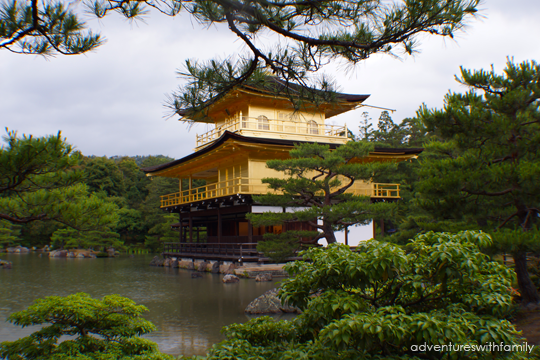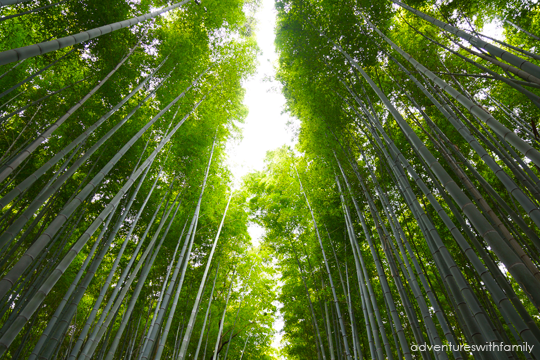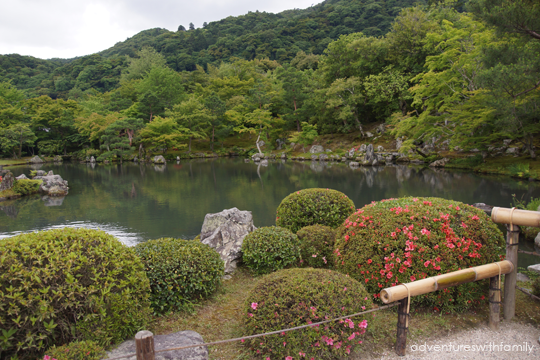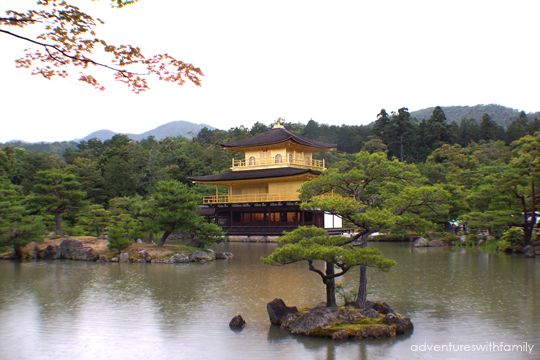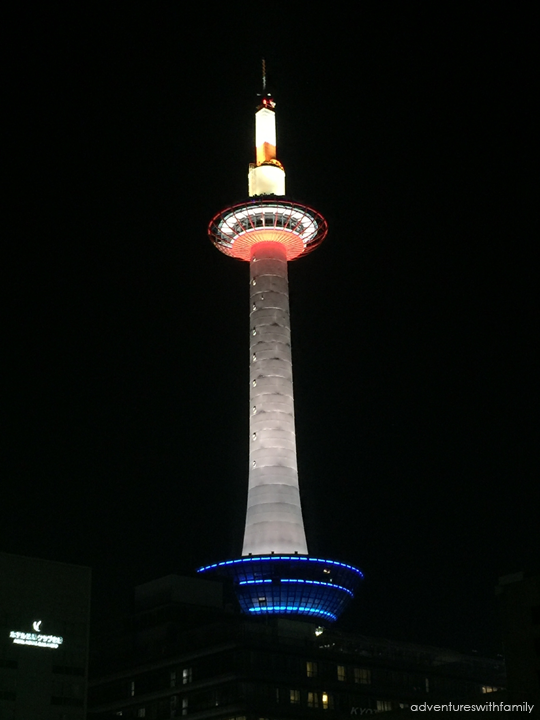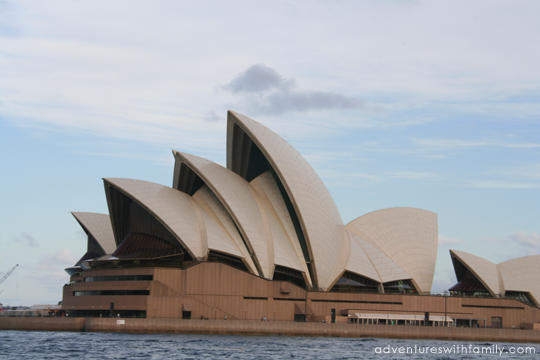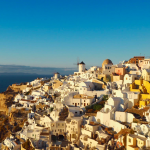Kyoto is one of the most fascinating cities in Japan rich in history and tradition dating back centuries. It was once the capital city of Japan and home to the emperor. As a city that was spared from destruction during the world war, Kyoto is where you will find beautifully preserved traditional villages, imperial palace, and ancient buddhist temples. Kyoto is also where you will find geishas, traditional tea ceremonies, refined Japanese cuisine, and sublime gardens.
KYOTO DAY 1
We spent our first day around the Higashiyama area where we visited famous Kiyomizudera temple, and explored the preserved historic streets of old Kyoto.
We purchased a two-day bus pass from the bus interchange above Kyoto station, then took bus 100 or 206 and travel about 15 minutes or around 8 stops to Kiyomizu-michi bus stop. The buses had monitors indicating clearly the various bus stops and which stop we were currently at. Thankfully, the bus stop names appearing on the monitor were both in English and Japanese. We were also given a bus map which you can also download from here – Kyoto bus map in English.
Yasaka Pagoda
After crossing the road, we walked along the historic street towards Yasaka Pagoda and Kiyomizudera.
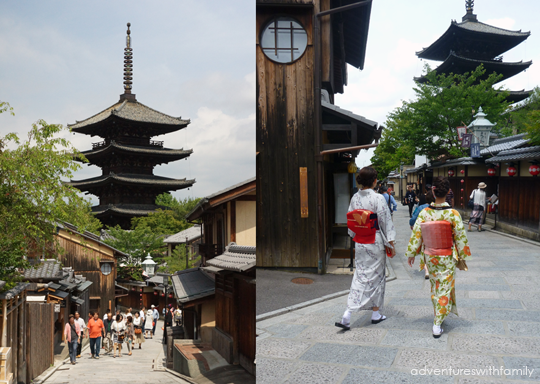
Kyoto Pottery
Along the way, we passed by Kyoto Pottery Center selling pretty Japanese-style potteries.
My girls were interested to try out this 100-year-old craft, and since the price was reasonable, I signed them up and they both decided to make a bowl for themselves. They had fun learning pottery from the Japanese experts and even though it was an unplanned activity, the bowls they made were their most treasured souvenirs from Japan. The bowls were delivered directly to our home about 4 weeks later after they were dried and painted. They even personalised the bowl by engraving their names at the base of the bowls.
I wished they could deliver the pretty sink above for me as well.
Visit their website kyototoujikikaikan.or.jp for more details.
Kiyomizudera
After the pottery session, we continued walking up the Ninenzaka and Sannenzaka stairs to Kiyomizudera.

There were so many people clad in colourful rented kimonos with hair all done up walking around Kiyomizudera. It was a nice place to walk and soak in the traditional Japanese atmosphere.

Kiyomizudera temple is a pure water temple and one of the most celebrated temples in Japan.

Apart from the great view of Kyoto, the interesting fact about Kiyomizudera was that the massive structure was built without a single nail!
The Old Kyoto
After Kiyomizudera, we returned back to Ninen-zaka and Sannen-zaka and explored the preserved historic buildings of old Kyoto.


There were a variety of shops selling kimonos and unique Japanese souvenirs and snacks.

From the old Kyoto streets, we could have gone to the Maruyama-Goen Park and Gion (where you can find many geishas walking along the streets), but the kids were hungry, so we headed to a popular sushi place called Ganko Sanjo Sushi. Read more about our food exploration here.
To reach there, we took bus 12 or 37 and walked across the bridge. Alternatively, take the Keihan Line from Gion station to Sanjo station and walk to Ganko Sanjo Honten.
From Ganko Sanjo Honten, we could have walked to Teramachi street and continue walking to the famous Nishiki market, but the kids were so tired after walking so much that we decided to call it a day and headed to our hotel to enjoy an onsen bath and a sumptuous Kyo Keiseki dinner.
We took bus 205 to get to Kyoto station from Ganko Sanjo or Nishiki market.
Read more about our stay at a traditional Japanese Inn called Yuzanso Ryokan.
KYOTO DAY 2
On the second day, we spent our time around Arashiyama and Kinkaku-ji areas.
Arashiyama Bamboo Forest
Our favourite attraction in Kyoto is the Arashiyama Bamboo forest.
We took a 15 minute train ride on the JR Sagano train from Kyoto station to Saga Arashiyama station. There is a sign pointing to the right for the path to walk to the forest. It takes about 10 minutes to walk to the start of the forest.
Kyoto’s Sagano Bamboo forest is considered to be one of the most beautiful forests in the world. As we entered the forest, the world outside suddenly seemed so far away. We can hear nature’s music through the distinct rustling sounds of the towering bamboo stalks that sway in the wind.
The forest was also much cooler as the sun filters through the densely packed grove.
Tenryu-ji Zen Temple and Garden
The bamboo forest has an entrance to one of the top five temples in Kyoto – the Tenryu-ji temple.

Tenryu-ji is said to have one of the nicest Zen gardens in Kyoto.

The garden is filled with pretty flowers that we have never seen before.
Keifuku Electric Railway
After Tenryu-ji temple, we walked about 10 minutes to the Keifuku (Randen) Electric Railway and bought tickets to take us to our next destination. While waiting for the train, we walked around the Kimono forest (photo on the right)
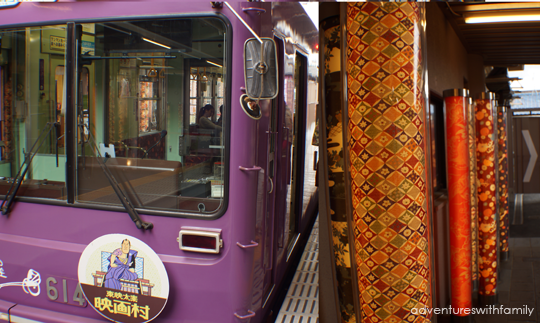
We took the Arashiyama Line on the Keifuku Electric Railway to Kitabiranotsuji station and transfer to the Kitano Line to Kitano Hakubaicho station. Then, we took a short bus ride on 102, 204 or 205 to Kinkaku-ji. The trains and buses had TV monitors showing the stations, so it was quite easy to figure out where to stop.
Kinkaku-ji Golden Temple
Kinkaku-ji is a Zen buddhist temple where the top two floors are completely covered in gold leaf. It is arguably the most stunning building in the whole of Kyoto.
We walked around the sublime gardens at Kinkaku-ji before heading back to Kyoto station.
We took bus 101 or 205 to Kyoto station.
KYOTO DAY 3
Fushimi Inari Torii Gates
The red Torii gates at Fushimi Inari is one of the best places to take pictures in Kyoto.
Located two stops away from Kyoto station on the JR Nara line, Fushimi Inari is the head shrine of Inari, what Japanese believe to be the god of rice.
Gion – Kyoto’s Geisha District
At the heart of Kyoto is Gion, a traditional entertainment district most famously known as Kyoto’s geisha district.
As we crossed the river to the preserved streets of Gion, we found ourselves walking back in time, where everything around us were old and traditional. As night falls, we saw traditional lanterns lit in front of teahouses and maiko. We even saw a geisha hurrying to her appointment.
In the modern side of Gion, there were many shops selling uniquely Japanese souvenirs like these cute Japanese purses.
Other than souvenirs, we found very interesting Japanese desserts and cakes like the one below.
Kyoto’s Traditional Kaiseki Dinner
One of the best culinary experiences to enjoy is having a traditional Japanese kaiseki dinner. Originally presented to royals and nobles, this multi-course meal is not only about the beautifully plated food, but also about the freshest ingredients of the season and warm Japanese hospitality. We had our kaiseki dinner at Minokichi restaurant at Hotel New Hankyu near Kyoto station.
Kyoto Tower
Our last stop was the Kyoto Tower, which was just in front of the Kyoto station.
Our trip to Kyoto was part of our 11-day trip to Japan. More about our 11-day Japan itinerary.
After Kyoto, we visited the beautiful Japanese village of Shirakawa-go and Takayama, followed by a trip to the Snow Wall.
Tips
- All the famous attractions in Kyoto were packed with tourists. To avoid the crowds, try to start the day early. The Arashiyama bamboo forest is open all day all night, so the earlier you go, the better the chance to avoid the crowd.
- Stay in a traditional Japanese inn while you are in Kyoto. We stayed at a nice one at Yuzanso Ryokan. Read more about our stay at Yuzanso Ryokan.
- For muslim visitors, read this post on Must-try Halal Restaurants in Kyoto.
- If you like to see performing arts like the Japanese tea ceremony and Japanese dance, visit the Gion corner.

